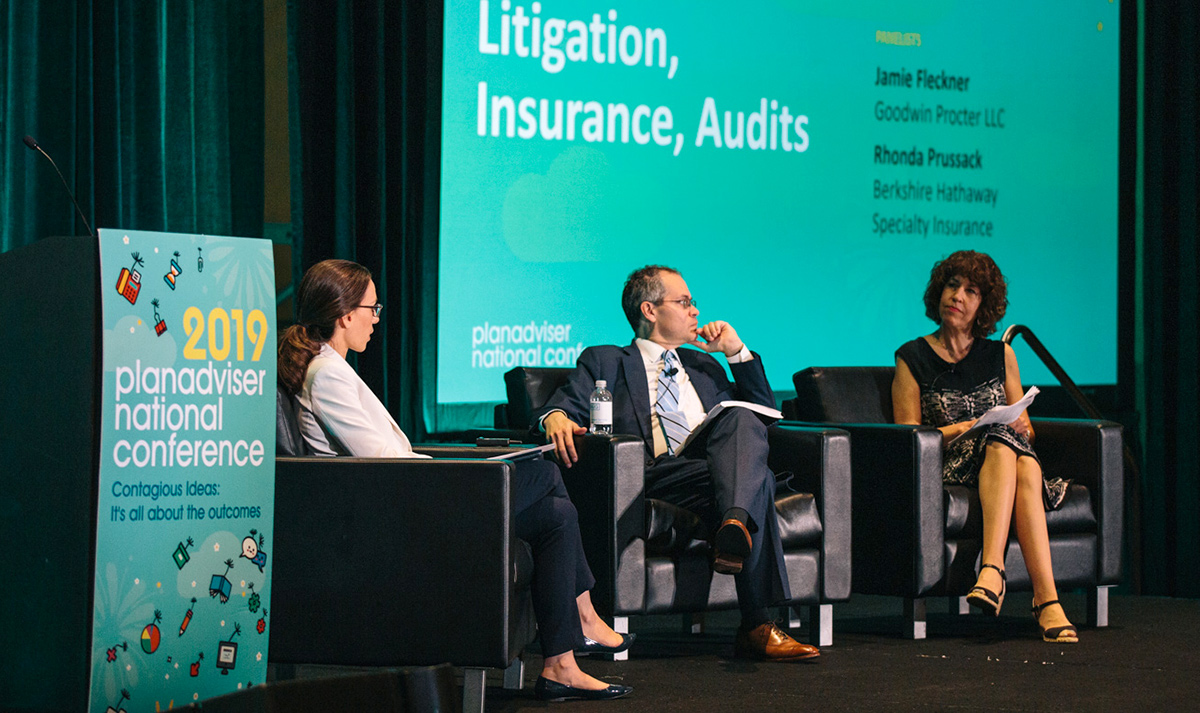PANC 2019: Risk Management for Advisers
Expert attorneys and fiduciary insurance carriers demonstrate how advisers can put their best foot forward.

From left: Alison Cooke Mintzer, PLANADVISER; Jamie Fleckner, Goodwin Procter; and Rhonda Prussack, Berkshire Hathaway Specialty Insurance.
The final day of the 2019 PLANADVISER National Conference featured a timely panel discussion on the ever-evolving topic of retirement plan litigation and fiduciary risk management.
Speakers on the panel included Jamie Fleckner, partner with Goodwin Procter and chair of the firm’s Employee Retirement Income Security Act (ERISA) litigation practice, and Rhonda Prussack, senior vice president and head of fiduciary and employment practices liability at Berkshire Hathaway Specialty Insurance.
Asked for an overview of recent action in ERISA lawsuits, Fleckner said the wave of litigation unfortunately just keeps coming.
“It’s been now almost 20 years of evolution in this space,” he noted. “These lawsuits really began back when Enron collapsed—that was really the initial trigger, in some sense. The litigation first focused on the offering of non-diversified company stock. Then in 2006 or 2007, we started seeing suits about the diversified investments as well.”
As Fleckner and Prussack explained, the suits initially targeted plans with $1 billion or more in assets, but over the years, the plan sponsors being targeted have shrunk significantly in size. Fleckner himself has defended plan sponsors with less than $25 million in plan assets.
“There are now more than 15 firms that are zooming into this area, including some traditional securities litigators,” Prussack said. “That’s part of the reason why these cases are going downstream. The fist firms to move into this space were only interested in very big paydays, but these other firms are very happy to have a payday of only a few million dollars or even several hundred thousand dollars.”
Fleckner agreed with this point, noting that in 2019, two-thirds of the suits that have been filed were brought by law firms that have never previously filed in excessive fee fiduciary breach case under ERISA.
“Hopefully, one result of the rush of new firms entering the space will be that the trial judges realize many of them don’t really know what they are doing,” Fleckner said. “We’ve seen this occur in other areas of the law. When it becomes clear that plaintiffs’ attorneys are really chasing results without a clear understanding of the law, you start to see courts push back. I think there is a chance that could happen here. Frankly some of these latest complaints make no sense at all.”
Fleckner and Prussack suggested there is some evidence emerging that more advisers are being dragged into litigation alongside their smaller plan clients. Their theory to explain this is that smaller employers may not have large pots of money to pay settlements, so it makes sense from the litigator’s perspective to drag as many parties into the litigation as possible. They also presume that, in these smaller plans, the advisers’ expertise is more central to the ongoing design and operation of the plan.
Asked for insight about what advisers and their plan sponsor clients can do to protect themselves ahead of the filing of litigation, Prussack had a lot to say.
“Well before we get to the stage of active litigation, in the underwriting of putting up millions of dollars in fiduciary insurance, we try to determine that they have prudent processes and procedures in place,” she explained. “For advisers, we examine closely their fee structures; if there have been recent changes to the compensation model and why those were made; how they are dealing with the industry pressures that are being placed upon them to change the fees structures; and more. A big component of these lawsuits revolves around revenue sharing, so we take a close look at that as well.”
Fleckner and Prussack said documented proof of a prudent process is paramount in defending against ERISA fiduciary breach cases. Fiduciaries will shine in a bright light from trial judges’ perspective if they can show their decisions were driven by a recurring process, featuring regular meetings and the flow of information on a regular basis. Fiduciaries must be able to show they are paying regular attention to the plan—both its challenges and its potential opportunities to take advantage of market developments, the two experts said.
You Might Also Like:

What Market Abuses Are DOL’s Fiduciary Proposal Supposed to Prevent?

Retirement Industry People Moves – 3/15/24
